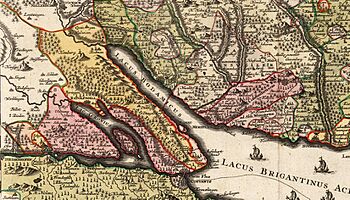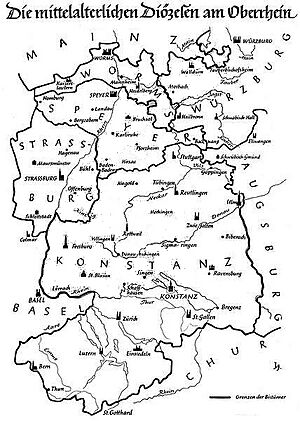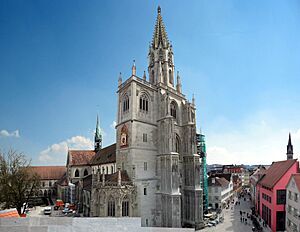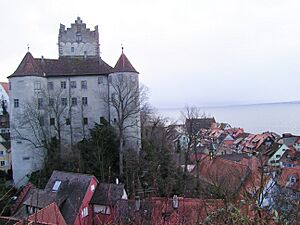Prince-Bishopric of Constance facts for kids
The Prince-Bishopric of Constance was a special kind of state in the old Holy Roman Empire. It was ruled by a bishop who was also a prince! This area existed from the mid-1100s until 1803.
The bishop of Constance had two jobs: he was the ruler of this small principality, and he was also the religious leader of a much larger area called the Diocese of Constance. This diocese was founded around 585 AD and lasted until 1821. It was much bigger than the principality, covering parts of what is now Germany, Switzerland, and Austria.
Quick facts for kids
Prince-Bishopric of Constance
Hochstift Konstanz
|
|||||||||
|---|---|---|---|---|---|---|---|---|---|
| 1155–1803 | |||||||||

The Bishopric of Constance lying astride the western end of Lake Constance
|
|||||||||
| Status | Prince-Bishopric | ||||||||
| Capital | Konstanz Meersburg (from 1527) |
||||||||
| Common languages | Low Alemannic | ||||||||
| Historical era | Middle Ages Early modern period |
||||||||
|
• Missionary diocese established
|
585 | ||||||||
|
• Prince-Bishopric
|
1155 | ||||||||
| 1414–18 | |||||||||
|
• Joined Swabian Circle
|
1500 | ||||||||
|
• Mediatised to Baden
|
1803 | ||||||||
|
• Diocese dissolved
|
1821 | ||||||||
|
|||||||||
Contents
Where Was the Prince-Bishopric Located?
The Prince-Bishopric of Constance was spread out around the western part of Lake Constance. It included areas like the Höri peninsula and the High Rhine river. It also covered the Monastic Island of Reichenau and the Linzgau region.
The city of Konstanz itself was not part of the prince-bishopric. It was a "free imperial city," meaning it ruled itself. To the south, the bishop's land touched the Thurgau region, which was taken over by the Swiss Confederacy in 1460.
It's important not to confuse the small prince-bishopric with the much larger diocese of Constance. The diocese covered a huge area. This included most of what is now the German state of Baden-Württemberg. It also stretched across a big part of Switzerland, all the way to the Gotthard Pass. A small piece of Austria's Vorarlberg region was also part of it.
The Prince-Bishop was the ruler of the small principality. But in the wider diocese, his power was mostly about religious duties. He was like any other bishop in that larger area.
A Brief History of Constance
The Diocese of Constance was one of the largest in Germany. It was started in the late 500s. This happened as Christian faith spread among the Alamanni tribes around Lake Constance. At first, it was part of the Archdiocese of Besançon. Later, in 782, it became part of the Archdiocese of Mainz.
In 1155, Emperor Frederick I Barbarossa officially recognized the bishop as a prince. This meant the bishopric became an "Imperial Estate." This gave it special rights within the Holy Roman Empire.
Over the centuries, the prince-bishopric's territory got smaller. This was due to pressure from both the Swiss Confederacy and the powerful House of Habsburg. The city of Constance also gained independence. It became a free imperial city. This meant the bishop's power in the city was limited to just the area around the cathedral.
In 1527, during the Protestant Reformation, the Prince-Bishop moved his main office. He moved it across Lake Constance to Meersburg. However, the city of Constance later rejoined the Catholic side. This was thanks to the Habsburgs. In 1548, Constance lost its status as a free imperial city. It became part of the Habsburg lands.
The large Diocese of Constance faced many challenges during the Reformation. Many Catholic churches and monasteries were closed. This happened in areas of Swabia and Switzerland that became Protestant.
In 1803, the Prince-Bishopric was finally dissolved. This event was part of a big change in Germany called the German Mediatisation. Its land was then added to the Margraviate of Baden.
The diocese itself was dissolved later, in 1821. This was done by Pope Pius VII. The areas of the diocese in Baden became part of a new archdiocese in Freiburg in 1827. The Swiss parts joined the Diocese of Basel.
Some Important Bishops of Constance
Here are a few notable bishops who led the Diocese of Constance over the centuries:
- Maximus (first bishop of the re-established bishopric, around 590)
- Solomon III (890–919)
- Conrad I (935–975)
- St Gebhard (979–995)
- Gebhard III (1084–1110)
- Konrad von Tegerfelden (1209–1233)
- Hugo von Hohenlandenberg (1496–1529; 1531/2)
- Mark Sittich von Hohenems (1561–1589)
- Marquard Rudolf von Rodt (1689–1704)
- Karl Theodor von Dahlberg (1799–1817) - the last official bishop.
Images for kids









